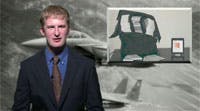NASHUA, N.H., 25 Sept. 2012. In this week's Military & Aerospace Electronics Report, Skyler Frink discusses the U.S. military's recent tests of Electronic Flight Bags and what benefits they could bring to the Air Force.
This is the Military & Aerospace Electronics Report, I'm Skyler Frink.
Electronic Flight Bags, which have already begun taking the place of traditional flight bags in some commercial airliners, may be making their debut on the military scene soon. This switch comes after over a year of looking into the technology from a military perspective.
Electronic Flight bags, which began testing in C-130 Hercules aircraft in July, are drawing close to the halfway point of their six month trial.
Electronic flight bags, which have already been approved by the FAA for some commercial airlines, save time and money while increasing overall efficiency. An Electronic Flight Bag replaces the cumbersome flight bag of pilots with an easy-to-use tablet computer. This comes with great cost savings, as it reduces the weight of the plane by 50 to 60 pounds and saves on the cost of paper. Estimated annual savings from eliminating the need for printing and distributing flight documents was placed at $5 million by Mobility Air Forces.
While only time will tell whether Electronic Flight Bags will replace traditional flight bags, the Air Force already has plans to purchase up to 18,000 tablets if the tests go well.
For the Military & Aerospace Electronics Report, I'm Skyler Frink.

